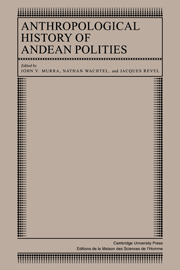Book contents
Part II - The ethnic group and the state
Published online by Cambridge University Press: 05 October 2010
Summary
Built up through successive conquests of many and diverse ethnic groups, the Inka state continued to utilize preexisting Andean institutions. It looms as the supreme polity, crowning all the embedded and pyramidal ethnic structures it had incorporated. Kin ties and ethnic solidarities, the promises of assymetrical reciprocity and redistribution, were all systematically reutilized as ideological disguises justifying new social relations. A qualitative threshold was crossed as the Inka state expanded: The development of a state apparatus, with its own dynamic and logic, suggested by the increase in the numbers of mitmaq colonists, yana retainers and aqlla weavers – all separated from their ethnic base. Do we merely imagine the risk and fundamental challenge that we detect in this change?
Thus the perspective changes, depending on whether one's study centers on the organization of the state, viewed from above, or whether one observes from below the more accessible ethnic groups or older polities. We mentioned above the disappointing awareness that our understanding of the Inka state has not kept up with the rhythm of information concerning other Andean institutions. Marcos Jiménez de la Espada, who died in 1898, has had no successor as a locator and editor of unfamiliar eyewitness sources. Waman Puma's “letter to the king” of 1615, published by Paul Rivet in 1936, has been reprinted several times; in 1980 a critical edition, with translations of the texts in Quechua and the indexes to facilitate its use was published in Mexico.
- Type
- Chapter
- Information
- Anthropological History of Andean Polities , pp. 47 - 48Publisher: Cambridge University PressPrint publication year: 1986



